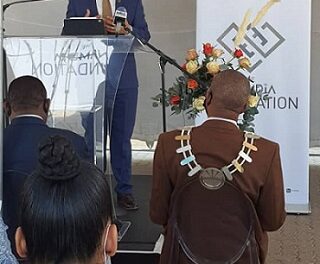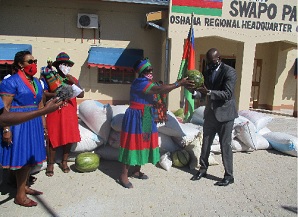
On 30 August 2022, Headspring Investments (Pty) Ltd arranged a Public Dialogue themed Uranium Exploration: ecology, radiation and safety.
The agenda covered the groundwater survey findings in the Stampriet Aquifer Basin (SAB) in Namibia and the international track-record of modern uranium mining technologies.
Representatives from the Ministry of Mines and Energy, Namibian Agricultural Union, Namibian Uranium Association, the Namibia University of Science and Technology, University of Namibia, SAUM, Radiation Protection Authority, local farmers and Media attended the Public Dialogue.
Following the opening remarks on the huge and crucial impact that the uranium mining sector has on the economy and prosperity of Namibia, Dr. Roy Miller presented his view points and concerns regarding uranium mining impacts on the drinking water of the SAB.
During his speech, Dr. Miller stated: “Groundwater is a critical and permanent commodity in the SAB and must be protected for present and future generations”.
International experts from the Czech Republic (EU), Canada, USA, Kazakhstan and the Russian Federation, who were invited to join the Public Talks, and Headsprings Investments (Pty) Ltd. representatives, agreed on the necessity to consider the groundwater safety as of utmost importance and shared their professional expertise in uranium mining, hydro(geo)logy, groundwater rehabilitation and radiation studies throughout the world on experiences regarding ISR uranium mining projects.
In accordance with International Atomic Energy Agency (IAEA) requirements, as part of the exploration activities and baseline determination, Headspring Investments (Pty) Ltd., conducted water assessments in the SAB within the boundaries of the Exclusive Prospecting Licenses. Analysis for radionuclides in 63 water wells demonstrated high concentrations above World Health Organization’s limits both for Alpha and Beta activity in some of the farmers’ wells located along the main ore body. This is a result of natural radioactive decay of uranium mineralization. Experts ensured that uranium, as a contamination source, will be removed from the relevant aquifer during ISR mining, while ensuring that the necessary control measures are in place.
Kirill Egorov-Kirillov, Director of Mining Projects of Uranium One JSC (mother company of the Headspring Investments (Pty) Ltd), explained that the area of the potential effect on the aquifer horizon is limited to the ore body zone that covers less than 1% of the SAB.
However, they advised that an extensive, independent study should be done to determine the full extent of natural contamination.
Both Dr. Alla Udalova, professor of the Nuclear University MEPhI and mining engineer and hydrogeologist from the Czech Republic, Jan Fajgl, emphasized that radioactivity is a natural phenomenon and part of the environment.
“To eliminate the risks of radiation we shall establish sound regulations based on the World Health Organization and the International Commission on Radiological Protection (ICRP). It is of utmost importance to test water for radionuclides in certified and available laboratories,” said Fajgl.
Fajgl added, “Further groundwater analysis should be made to define natural contamination zone and to ensure Governmental control of its usage. Namibian national laboratory for groundwater radionuclide analysis should be established.”
Dr. Wayne Anderson, WA Safety Consulting Director, Canada, said that radiation potential hazards can be managed using well-established engineering tools through careful monitoring and adherence to ISO requirements.
Mr. Fletcher Newton shared the experience of low pH ISR uranium mining in Wyoming (USA), which is famous for its agricultural, tourist and mining sectors. Lance is one of the largest uranium projects in Wyoming, licensed and constructed by Peninsula’s wholly owned US subsidiary, Strata Energy Inc.
The company conducted groundwater restoration studies, which has shown that the uranium concentration was reduced even to lower levels than the target restoration values during simulated groundwater restoration, following leaching with a sulfuric acid-based lixiviant.
Headspring Investments (Pty) Ltd., which has the environmental clearance certificates to continue with the exploration activities on their EPLs, made it clear that they are focused on transparency and is considering establishing a social council to foster regular and transparent communication.
During the questions and answers session, the attendees discussed the necessity to conduct more research and to collect more information on the baseline.
Local communities supported the idea to create the public discussion mechanism where all interested and affected parties can address their questions to the company and receive answers under the auspice of the Government of Namibia.
In the photo: Lively presentations took place and were followed by robust engagements with the audience.






